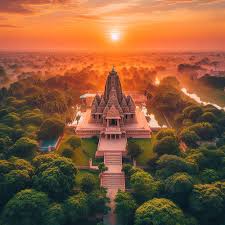Ayodhya
Ayodhya, a city steeped in mythological and historical significance, is one of the most revered pilgrimage destinations in India. Situated on the banks of the Sarayu River in Uttar Pradesh, Ayodhya is considered the birthplace of Lord Rama, a major deity in Hinduism. Its rich history, religious importance, and numerous temples attract millions of visitors every year.
Mythological Significance
Ayodhya is most famously known as the setting of the ancient Hindu epic, the Ramayana. According to the Ramayana, Ayodhya was the capital of the Kosala Kingdom and the birthplace of Lord Rama, the seventh incarnation of Vishnu. The epic details Rama's life, including his exile, the abduction of his wife Sita by the demon king Ravana, and his subsequent victory over Ravana. This mythological connection has made Ayodhya a central pilgrimage site for Hindus.
Historical Background
The history of Ayodhya dates back several millennia. It is believed to be one of the oldest cities in India, with references found in ancient texts such as the Vedas and the Ramayana. Over the centuries, Ayodhya has been ruled by various dynasties, including the Mauryas, Guptas, and the Delhi Sultanate, each leaving its mark on the city’s cultural and architectural heritage.
Temples and Religious Sites
Ayodhya is home to numerous temples and religious sites that are significant to Hindus. The most prominent among them is the Ram Janmabhoomi, believed to be the exact birthplace of Lord Rama. The site has been the center of a long-standing and controversial dispute between Hindus and Muslims, leading to significant political and social upheaval. In 2019, the Supreme Court of India ruled in favor of building a temple at the disputed site, which is currently under construction.
Other notable temples in Ayodhya include:
- Hanuman Garhi: A temple dedicated to Hanuman, the devoted follower of Lord Rama. It is located on a hilltop and is one of the most visited temples in Ayodhya.
- Kanak Bhawan: A palace-like temple that is believed to have been gifted to Sita by Rama’s stepmother, Kaikeyi. It is known for its beautiful idols of Rama and Sita adorned in gold.
- Nageshwarnath Temple: This temple is dedicated to Lord Shiva and is associated with Kush, the son of Lord Rama. It is said to have been established by Kush himself.
Festivals and Celebrations
Ayodhya is a vibrant city that comes alive during various Hindu festivals. The most significant of these is Diwali, which is celebrated with immense fervor. According to the Ramayana, Diwali marks the return of Lord Rama to Ayodhya after 14 years of exile. The city is adorned with lights and decorations, and large processions and cultural programs are held to celebrate the occasion.
Another major festival is Ram Navami, the birthday of Lord Rama. Devotees from across the country visit Ayodhya to take part in the festivities, which include religious rituals, processions, and recitations of the Ramayana.
Historical Sites and Monuments
Apart from its temples, Ayodhya also boasts several historical sites and monuments that reflect its rich heritage:
- Guptar Ghat: This is the place where Lord Rama is believed to have taken a dip in the Sarayu River before leaving for his heavenly abode. It is a serene spot and an important site for pilgrims.
- Tulsi Smarak Bhawan: This memorial is dedicated to the poet-saint Tulsidas, who wrote the Ramcharitmanas, an epic poem based on the Ramayana. The Bhawan houses a library and a research center on Tulsidas’s works.
- Treta Ke Thakur: A temple that is said to house the idols of Lord Rama, Sita, Lakshmana, and Hanuman, believed to have been installed by King Vikramaditya.
Modern Ayodhya
In recent years, Ayodhya has undergone significant development, particularly in the wake of the Supreme Court’s verdict on the Ram Janmabhoomi dispute. The construction of the Ram Temple has spurred infrastructure development, including better roads, improved public amenities, and increased tourism facilities. Efforts are also being made to preserve and promote the city’s cultural heritage through various government initiatives.

No comments:
Post a Comment